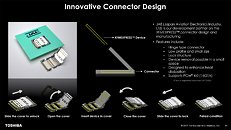Tuesday, August 6th 2019

Toshiba Announces the XFMExpress Socketed Non-volatile Memory Standard
Toshiba Memory today announced XFMExpress, a new standard of socketed internal non-volatile memory for use in thin-and-light consumer electronics, ultra-thin notebooks, and IoT devices. XFMExpress seeks to solve the increasing problem of repairability of thin-and-light devices, in which the SSD is hardwired onto the device's mainboard and non-replaceable. Toshiba believes M.2 doesn't fully meet the Z-height requirements of today's thin-and-light device designers, and hence there is need for a new space-saving storage device standard that remains internal to the device, but allows for repairability by swapping out the storage device.
This does not compete with SD Express, as it is not being pushed as a removable storage solution, but rather an internal storage device that's easy to replace. The XFMExpress effort consists of two components, the XFMExpress card, which has roughly similar dimensions to an SD card (14 mm x 18 mm x 1.4 mm), but performance and capacity rivaling full-fledged M.2 NVMe SSDs; and a new socket Toshiba designed in partnership with JAE (Japan Aviation Electronics corp). This socket, made of steel and contact points that have been directly soldered onto the device's mainboard, is an LGA, with a thin (<0.2 mm thick) retention brace.The XFMExpress standard uses PCI-Express x4 as its physical layer, and the NVMe protocol, requiring no additional drivers for NVMe-aware operating systems and firmware. The standard currently uses PCI-Express gen 3.0 x4, but will incorporate PCI-Express gen 4.0 x4 "very soon." Under the hood, an XFMExpress module has a controller, a DRAM cache, and stacked 3D NAND flash, and is capable of utilizing the interface bandwidth to the fullest.
This does not compete with SD Express, as it is not being pushed as a removable storage solution, but rather an internal storage device that's easy to replace. The XFMExpress effort consists of two components, the XFMExpress card, which has roughly similar dimensions to an SD card (14 mm x 18 mm x 1.4 mm), but performance and capacity rivaling full-fledged M.2 NVMe SSDs; and a new socket Toshiba designed in partnership with JAE (Japan Aviation Electronics corp). This socket, made of steel and contact points that have been directly soldered onto the device's mainboard, is an LGA, with a thin (<0.2 mm thick) retention brace.The XFMExpress standard uses PCI-Express x4 as its physical layer, and the NVMe protocol, requiring no additional drivers for NVMe-aware operating systems and firmware. The standard currently uses PCI-Express gen 3.0 x4, but will incorporate PCI-Express gen 4.0 x4 "very soon." Under the hood, an XFMExpress module has a controller, a DRAM cache, and stacked 3D NAND flash, and is capable of utilizing the interface bandwidth to the fullest.







12 Comments on Toshiba Announces the XFMExpress Socketed Non-volatile Memory Standard
Let's hope it gains traction and doesn't have that bad of a mark up compared to a regular NVME SSD.
It's becoming rarer and rarer to see ultrabooks with user-serviceable batteries, even changing drives requires taking off the entire back these days! And let's not even get to smartphones' trend of losing SD support (many already past that "archaic" idea removable batteries).
The mechanism should have been a typical slide-in instead so that it could be accessible near the ports or edge of any device and wouldn't require any Z height to service.
It's a good thing to recover, precisely one of the reasons I didn't go with an ultrabook for work is the lack of expansion possibilities, even Surface convertibles have soldered ram. Now we need mxm gpus to become popular.